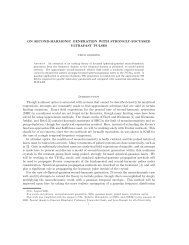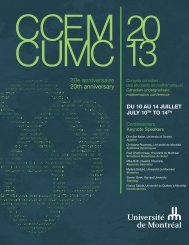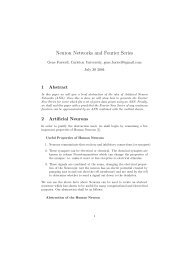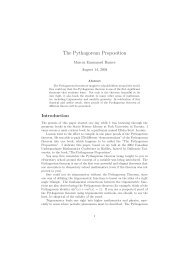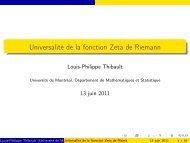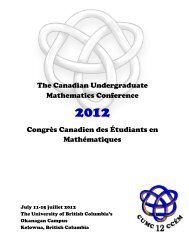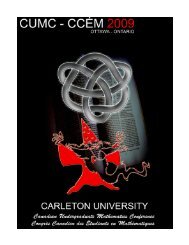booklet - CUMC - Canadian Mathematical Society
booklet - CUMC - Canadian Mathematical Society
booklet - CUMC - Canadian Mathematical Society
Create successful ePaper yourself
Turn your PDF publications into a flip-book with our unique Google optimized e-Paper software.
2.2 Student AbstractsMETRIC DIMENSION OF CAYLEY HYPERGRAPHSADAM BORCHERTA Graph is a representation of a set of vertices where some pairs of vertices areconnected by edges. A pair of vertices x and y are said to be resolved by a vertex w ifthe distance from x to w is not equal to the distance from y to w. A graph G is resolvedby a set of vertices W if every pair of vertices in G is resolved by some vertex in W. Aminimum resolving set is called a metric basis. The cardinality of a metric basis is themetric dimension of G. A hypergraph is a generalization of a graph, where an edge canconnect any number of vertices. The edge set E of a hypergraph H is a set of nonemptysubsets of the vertex set of H. I will give an overview of how we are approaching theproblem of the metric dimension of Cayley hypergraphs and present a new result.AN ERDŐS-KO-RADO THEOREM FOR SUBSET PARTITIONSADAM DYCKThe Erdős-Ko-Rado (EKR) theorem is an important result in combinatorics andgraph theory that looks at the sizes of t-intersecting families of finite k-subsets froman n-set, which can be proven using methods from both combinatorics or graph theory.EKR-like theorems can be established by considering other combinatorial objects—suchas permutations or multisets—and there are often multiple ways to prove these results.In this talk, I will introduce the notion of a (k, l)-subpartition, and comment on the sizeand structure of maximally intersecting families of such subpartitions. I will outline themain ideas behind my proof of the corresponding EKR-like result, and provide relevantexamples as necessary. To conclude, I will pose some conjectures on additional structuresof such intersecting families based on the size of n, as well as discuss my futurework with t-intersecting families. Some basic knowledge about counting methods andgraph theory will be assumed.Required Background: Basic combinatorics and basic graph theoryAN INVITATION TO FUNCTIONAL ANALYSISADITYA KUMARFun times will be had with inequalities, topological vectors spaces, and quantummechanics, as one steps foot into the realm of Functional Analysis. Motivations andhistorical development will be briefly discussed, alongside important uses and implementationsin both the pure mathematical universe and the physical mathematical universe(applied mathematics). A few important theorems will be discussed alongsidewith a few proofs. And of course, all necessary definitions, and jargon will be given.Just arrive with an open mind!Required Background: Basic Linear Algebra/Multivariable Calculus15



